
Tourism in Nicaragua
Encyclopedia
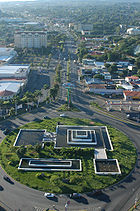
Nicaragua
Nicaragua is the largest country in the Central American American isthmus, bordered by Honduras to the north and Costa Rica to the south. The country is situated between 11 and 14 degrees north of the Equator in the Northern Hemisphere, which places it entirely within the tropics. The Pacific Ocean...
n President Daniel Ortega
Daniel Ortega
José Daniel Ortega Saavedra is a Nicaraguan politician and revolutionary, currently serving as the 83rd President of Nicaragua, a position that he has held since 2007. He previously served as the 79th President, between 1985 and 1990, and for much of his life, has been a leader in the Sandinista...
has stated his intention to use tourism to combat poverty throughout the country. The growth in tourism has positively affected the agricultural, commercial, and finance industries, as well as the construction industry. The results for Nicaragua's tourism-driven economy have been significant, with the nation welcoming one million tourists in a calendar year for the first time in its history in 2010.
History
During the Nicaraguan RevolutionNicaraguan Revolution
The Nicaraguan Revolution encompasses the rising opposition to the Somoza dictatorship in the 1960s and 1970s, the campaign led by the Sandinista National Liberation Front which led to the violent ousting of that dictatorship in 1979, and the...
in the '80s Nicaragua was not regarded as a place to travel and caused a decrease in tourism. However, rapid expansion of the tourist industry over the last decade has made it the nation's second largest industry. Over the last 7 years tourism
Tourism
Tourism is travel for recreational, leisure or business purposes. The World Tourism Organization defines tourists as people "traveling to and staying in places outside their usual environment for not more than one consecutive year for leisure, business and other purposes".Tourism has become a...
has grown about 70% nationwide with rates of 10%-16% annually. The country is mostly famous for its landscape
Landscape
Landscape comprises the visible features of an area of land, including the physical elements of landforms such as mountains, hills, water bodies such as rivers, lakes, ponds and the sea, living elements of land cover including indigenous vegetation, human elements including different forms of...
s, flora
Flora
Flora is the plant life occurring in a particular region or time, generally the naturally occurring or indigenous—native plant life. The corresponding term for animals is fauna.-Etymology:...
and fauna
Fauna
Fauna or faunæ is all of the animal life of any particular region or time. The corresponding term for plants is flora.Zoologists and paleontologists use fauna to refer to a typical collection of animals found in a specific time or place, e.g. the "Sonoran Desert fauna" or the "Burgess shale fauna"...
, wildlife
Wildlife of Nicaragua
The fauna of Nicaragua is characterized by a very high level of biodiversity. Much of Nicaragua's wildlife lives in protected areas. There are currently 78 protected areas in Nicaragua, covering more than , or about 17% of its landmass. These protected areas encompass a wide variety of habitats,...
, culture
Culture of Nicaragua
British possessions. The people of Nicaragua are mostly mestizos, and Spanish is invariably their first language. Nicaraguans are prone to refer to themselves as Nicas, Nicoyas & Pinoleros.-Culture:...
, beaches, lakes, and volcanoes. By 2010, the nation welcomed one million visitors--the most in its entire history for a calendar year. Nicaragua's tourism industry in 2010 raked in approximately 360 million dollars for the nation's economy.
According to TV Noticias (news program) on Canal 2
Televicentro (Canal 2)
Televicentro is a nationwide terrestrial television channel from Nicaragua owned by Televicentro de Nicaragua, S.A.- History :Televicentro de Nicaragua, S.A. was founded in December 1965 by Octavio Sacasa Sarria, first broadcast in March, 1966. It was the second television channel in Nicaragua,...
, a Nicaragua television station, the main attractions in Nicaragua for tourists are the beaches, scenic routes, the architecture of cities such as León and Granada and most recently ecotourism
Ecotourism
Ecotourism is a form of tourism visiting fragile, pristine, and usually protected areas, intended as a low impact and often small scale alternative to standard commercial tourism...
and agritourism
Agritourism
Agritourism, as it is defined most broadly, involves any agriculturally-based operation or activity that brings visitors to a farm or ranch. Agritourism has different definitions in different parts of the world, and sometimes refers specifically to farm stays, as in Italy...
, particularly in Northern Nicaragua.
Tourism
In 2005, 803,933 tourists visited Nicaragua, a noticeable improvement from the mere 579,165 in 2002. The tourism industry received US$Dollar
The dollar is the name of the official currency of many countries, including Australia, Belize, Canada, Ecuador, El Salvador, Hong Kong, New Zealand, Singapore, Taiwan, and the United States.-Etymology:...
240 million, outstripping the other main earner, coffee. That same year Nicaragua received more visitors than Panama
Panama
Panama , officially the Republic of Panama , is the southernmost country of Central America. Situated on the isthmus connecting North and South America, it is bordered by Costa Rica to the northwest, Colombia to the southeast, the Caribbean Sea to the north and the Pacific Ocean to the south. The...
. The majority of tourists came from the U.S., Europe
Europe
Europe is, by convention, one of the world's seven continents. Comprising the westernmost peninsula of Eurasia, Europe is generally 'divided' from Asia to its east by the watershed divides of the Ural and Caucasus Mountains, the Ural River, the Caspian and Black Seas, and the waterways connecting...
, and Central
Central America
Central America is the central geographic region of the Americas. It is the southernmost, isthmian portion of the North American continent, which connects with South America on the southeast. When considered part of the unified continental model, it is considered a subcontinent...
and South America
South America
South America is a continent situated in the Western Hemisphere, mostly in the Southern Hemisphere, with a relatively small portion in the Northern Hemisphere. The continent is also considered a subcontinent of the Americas. It is bordered on the west by the Pacific Ocean and on the north and east...
.
About 60,000 United States citizens visit Nicaragua yearly, primarily businessmen, tourists and others visiting relatives.
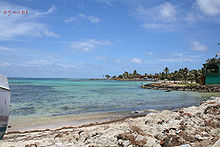
Granada, Nicaragua
Granada is a city in western Nicaragua and the capital of the Granada Department. With an estimated population of 110,326 , it is Nicaragua's fourth most populous city. Granada is historically one of Nicaragua's most important cities, economically and politically...
is the preferred spot for tourists. Also, the cities of León
León, Nicaragua
León is a department in northwestern Nicaragua . It is also the second largest city in Nicaragua, after Managua. It was founded by the Spaniards as Santiago de los Caballeros de León and rivals Granada, Nicaragua, in the number of historic Spanish colonial homes and churches...
, Masaya
Masaya
Masaya, culturally known as the City of Flowers, is the capital city of Masaya department. It is situated approximately 14 km west of Granada and 31 km southeast from Managua. The town of Masaya is situated just East of Masaya Volcano , an active volcano from which the city takes its name...
, Rivas
Rivas
Rivas is a city and municipality in southwestern Nicaragua on the Isthmus of the same name. The city proper is the capital of the Department of Rivas and administrative centre for the surrounding municipality of the same name.-Overview:...
and the likes of San Juan del Sur
San Juan del Sur
San Juan del Sur is a municipality and coastal town on the Pacific Ocean, in the Rivas department in south-west Nicaragua. San Juan del Sur is popular among surfers and is a vacation spot for many Nicaraguan families and foreign tourists....
, San Juan River
San Juan River (Nicaragua)
The San Juan River , also known as El Desaguadero , is a 192.06 km river that flows east out of Lake Nicaragua into the Caribbean Sea. A large section of the border between Nicaragua and Costa Rica runs on the right bank of the river...
, Ometepe
Ometepe
Ometepe is an island formed by two volcanoes rising from Lake Nicaragua in the Republic of Nicaragua. Its name derives from the Nahuatl words ome and tepetl , meaning two mountains...
, Mombacho
Mombacho
Mombacho is a stratovolcano in Nicaragua, near the city of Granada. It is 1344 metres high. The Mombacho Volcano Nature Reserve is one of 78 protected areas of Nicaragua. Mombacho is an active volcano but the last eruption occurred in 1570...
Volcano, and others are main tourist attractions. In addition, ecotourism
Ecotourism
Ecotourism is a form of tourism visiting fragile, pristine, and usually protected areas, intended as a low impact and often small scale alternative to standard commercial tourism...
and surfing
Surfing
Surfing' is a surface water sport in which the surfer rides a surfboard on the crest and face of a wave which is carrying the surfer towards the shore...
attract many tourists to Nicaragua.
Also, a popular destination are the Corn Islands
Corn Islands
The Corn Islands are two islands about east off the Caribbean coast of Nicaragua, constituting one of 12 municipalities of the Región Autónoma del Atlántico Sur department...
located about 70 km east off the Caribbean
Caribbean
The Caribbean is a crescent-shaped group of islands more than 2,000 miles long separating the Gulf of Mexico and the Caribbean Sea, to the west and south, from the Atlantic Ocean, to the east and north...
coast of Nicaragua near Bluefields
Bluefields
Bluefields is the capital of the municipality of the same name, and of Región Autónoma del Atlántico Sur in Nicaragua. It was also capital of the former Zelaya Department, which was divided into North and South Atlantic Autonomous Regions...
. They have been regarded as a "tropical paradise" by the Los Angeles Times
Los Angeles Times
The Los Angeles Times is a daily newspaper published in Los Angeles, California, since 1881. It was the second-largest metropolitan newspaper in circulation in the United States in 2008 and the fourth most widely distributed newspaper in the country....
. Cruise ships have been docking in San Juan del Sur
San Juan del Sur
San Juan del Sur is a municipality and coastal town on the Pacific Ocean, in the Rivas department in south-west Nicaragua. San Juan del Sur is popular among surfers and is a vacation spot for many Nicaraguan families and foreign tourists....
since January 2000 and average 50,000 tourists alone every year, some who partake in tours to nearby Lake Cocibolca and the colonial city of Granada.
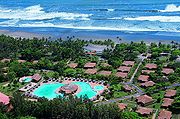
Latin America
Latin America is a region of the Americas where Romance languages – particularly Spanish and Portuguese, and variably French – are primarily spoken. Latin America has an area of approximately 21,069,500 km² , almost 3.9% of the Earth's surface or 14.1% of its land surface area...
by Interpol
Interpol
Interpol, whose full name is the International Criminal Police Organization – INTERPOL, is an organization facilitating international police cooperation...
and many other sources, with only 12 crimes for every 100,000 citizens. Nicaragua also holds the largest lake in Central America, about 700 species of birds, and unspoiled natural beauty, despite all this it is still the least visited country in the region. However, the lower number of tourists help Nicaragua keep low prices, and an "off-the-beaten-track" feel.
Rural and community-based tourism
CECOCAFEN is an organization of coffee cooperatives in Northern Nicaragua that manage a rural and community-based tourism project, which has been developed with support from the Lutheran World ReliefLutheran World Relief
Lutheran World Relief is an international nonprofit organization specializing in International Development and Disaster Relief. It was headquartered in New York, but has been based in Baltimore, Maryland since 1995....
. CEOCAFEN was founded in 1997, the drop in international coffee prices is what started the CECCOAFEN project in 2003. Tourism allows farmers to receive new opportunities in alternative markets, harvest coffee and diversify their income. CECOCAFEN offers visitors the opportunity to visit a coffee farm, learn about coffee craftsmanship, and even to stay overnight on a coffee farm and explore with a community guide.
Ecological tourism
Eco-tourism aims to be ecologically and socially conscious, it focuses on local culture, wilderness, and adventure. Nicaragua's eco-tourism is growing with every passing year, it boasts a number of eco-tourist tours and perfect places for adventurers. Nicaragua has three eco-regions, the Pacific, Central and Atlantic which contain volcanoes, tropical rainforest and agricultural land.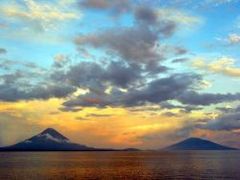
Biodiversity
Biodiversity is the degree of variation of life forms within a given ecosystem, biome, or an entire planet. Biodiversity is a measure of the health of ecosystems. Biodiversity is in part a function of climate. In terrestrial habitats, tropical regions are typically rich whereas polar regions...
. More than Costa Rica, which is thought to hold more natural areas than Nicaragua. Nicaragua is also home to Bosawas, located in Northern Nicaragua, which is the largest rainforest north of the Amazon
Amazon Rainforest
The Amazon Rainforest , also known in English as Amazonia or the Amazon Jungle, is a moist broadleaf forest that covers most of the Amazon Basin of South America...
in Brazil
Brazil
Brazil , officially the Federative Republic of Brazil , is the largest country in South America. It is the world's fifth largest country, both by geographical area and by population with over 192 million people...
, and the largest lake in Central America
Central America
Central America is the central geographic region of the Americas. It is the southernmost, isthmian portion of the North American continent, which connects with South America on the southeast. When considered part of the unified continental model, it is considered a subcontinent...
, Lake Cocibolca. Lake Cocibolca attracts its fair number of tourist yearly, most of which primarily visit Ometepe
Ometepe
Ometepe is an island formed by two volcanoes rising from Lake Nicaragua in the Republic of Nicaragua. Its name derives from the Nahuatl words ome and tepetl , meaning two mountains...
, which is a large volcanic island formed by two volcanoes in the lake. Tourists typically visit and explore the flora and fauna found in the Charco Verde Nature Reserve.
Nicaragua's rich biodiversity
Biodiversity
Biodiversity is the degree of variation of life forms within a given ecosystem, biome, or an entire planet. Biodiversity is a measure of the health of ecosystems. Biodiversity is in part a function of climate. In terrestrial habitats, tropical regions are typically rich whereas polar regions...
also attracts many tourists to protected area
Protected area
Protected areas are locations which receive protection because of their recognised natural, ecological and/or cultural values. There are several kinds of protected areas, which vary by level of protection depending on the enabling laws of each country or the regulations of the international...
s such as the Indio Maíz Biological Reserve
Indio Maíz Biological Reserve
Indio Maíz Biological Reserve measures about 4,500 square kilometers and is situated on the southeastern corner of Nicaragua bordering the San Juan River. It is the second largest expanse of lowland rainforest reserve in Nicaragua and is referred to as "the gem of Central American nature reserves"...
, which holds a higher number in species of trees, birds, and insects than all of Europe.
International tourist arrivals
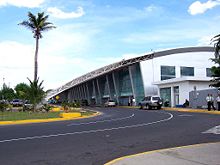
International airport
Nicaragua only has one international airport, the Augusto C. Sandino International Airport, located in ManaguaManagua
Managua is the capital city of Nicaragua as well as the department and municipality by the same name. It is the largest city in Nicaragua in terms of population and geographic size. Located on the southwestern shore of Lake Xolotlán or Lake Managua, the city was declared the national capital in...
.
Visa regulations
Tourists from AfghanistanAfghanistan
Afghanistan , officially the Islamic Republic of Afghanistan, is a landlocked country located in the centre of Asia, forming South Asia, Central Asia and the Middle East. With a population of about 29 million, it has an area of , making it the 42nd most populous and 41st largest nation in the world...
, Albania
Albania
Albania , officially known as the Republic of Albania , is a country in Southeastern Europe, in the Balkans region. It is bordered by Montenegro to the northwest, Kosovo to the northeast, the Republic of Macedonia to the east and Greece to the south and southeast. It has a coast on the Adriatic Sea...
, Angola
Angola
Angola, officially the Republic of Angola , is a country in south-central Africa bordered by Namibia on the south, the Democratic Republic of the Congo on the north, and Zambia on the east; its west coast is on the Atlantic Ocean with Luanda as its capital city...
, Armenia
Armenia
Armenia , officially the Republic of Armenia , is a landlocked mountainous country in the Caucasus region of Eurasia...
, Bosnia and Herzegovina
Bosnia and Herzegovina
Bosnia and Herzegovina , sometimes called Bosnia-Herzegovina or simply Bosnia, is a country in Southern Europe, on the Balkan Peninsula. Bordered by Croatia to the north, west and south, Serbia to the east, and Montenegro to the southeast, Bosnia and Herzegovina is almost landlocked, except for the...
, China, Cuba
Cuba
The Republic of Cuba is an island nation in the Caribbean. The nation of Cuba consists of the main island of Cuba, the Isla de la Juventud, and several archipelagos. Havana is the largest city in Cuba and the country's capital. Santiago de Cuba is the second largest city...
, Ecuador
Ecuador
Ecuador , officially the Republic of Ecuador is a representative democratic republic in South America, bordered by Colombia on the north, Peru on the east and south, and by the Pacific Ocean to the west. It is one of only two countries in South America, along with Chile, that do not have a border...
, Ghana
Ghana
Ghana , officially the Republic of Ghana, is a country located in West Africa. It is bordered by Côte d'Ivoire to the west, Burkina Faso to the north, Togo to the east, and the Gulf of Guinea to the south...
, Haiti
Haiti
Haiti , officially the Republic of Haiti , is a Caribbean country. It occupies the western, smaller portion of the island of Hispaniola, in the Greater Antillean archipelago, which it shares with the Dominican Republic. Ayiti was the indigenous Taíno or Amerindian name for the island...
, Iraq
Iraq
Iraq ; officially the Republic of Iraq is a country in Western Asia spanning most of the northwestern end of the Zagros mountain range, the eastern part of the Syrian Desert and the northern part of the Arabian Desert....
, Jordan
Jordan
Jordan , officially the Hashemite Kingdom of Jordan , Al-Mamlaka al-Urduniyya al-Hashemiyya) is a kingdom on the East Bank of the River Jordan. The country borders Saudi Arabia to the east and south-east, Iraq to the north-east, Syria to the north and the West Bank and Israel to the west, sharing...
, Lebanon
Lebanon
Lebanon , officially the Republic of LebanonRepublic of Lebanon is the most common term used by Lebanese government agencies. The term Lebanese Republic, a literal translation of the official Arabic and French names that is not used in today's world. Arabic is the most common language spoken among...
, Liberia
Liberia
Liberia , officially the Republic of Liberia, is a country in West Africa. It is bordered by Sierra Leone on the west, Guinea on the north and Côte d'Ivoire on the east. Liberia's coastline is composed of mostly mangrove forests while the more sparsely populated inland consists of forests that open...
, Mali
Mali
Mali , officially the Republic of Mali , is a landlocked country in Western Africa. Mali borders Algeria on the north, Niger on the east, Burkina Faso and the Côte d'Ivoire on the south, Guinea on the south-west, and Senegal and Mauritania on the west. Its size is just over 1,240,000 km² with...
, Mozambique
Mozambique
Mozambique, officially the Republic of Mozambique , is a country in southeastern Africa bordered by the Indian Ocean to the east, Tanzania to the north, Malawi and Zambia to the northwest, Zimbabwe to the west and Swaziland and South Africa to the southwest...
, Nepal
Nepal
Nepal , officially the Federal Democratic Republic of Nepal, is a landlocked sovereign state located in South Asia. It is located in the Himalayas and bordered to the north by the People's Republic of China, and to the south, east, and west by the Republic of India...
, Nigeria
Nigeria
Nigeria , officially the Federal Republic of Nigeria, is a federal constitutional republic comprising 36 states and its Federal Capital Territory, Abuja. The country is located in West Africa and shares land borders with the Republic of Benin in the west, Chad and Cameroon in the east, and Niger in...
, North Korea, Pakistan
Pakistan
Pakistan , officially the Islamic Republic of Pakistan is a sovereign state in South Asia. It has a coastline along the Arabian Sea and the Gulf of Oman in the south and is bordered by Afghanistan and Iran in the west, India in the east and China in the far northeast. In the north, Tajikistan...
, the Palestinian National Authority
Palestinian National Authority
The Palestinian Authority is the administrative organization established to govern parts of the West Bank and Gaza Strip...
, Romania
Romania
Romania is a country located at the crossroads of Central and Southeastern Europe, on the Lower Danube, within and outside the Carpathian arch, bordering on the Black Sea...
, Sierra Leone
Sierra Leone
Sierra Leone , officially the Republic of Sierra Leone, is a country in West Africa. It is bordered by Guinea to the north and east, Liberia to the southeast, and the Atlantic Ocean to the west and southwest. Sierra Leone covers a total area of and has an estimated population between 5.4 and 6.4...
, Somalia
Somalia
Somalia , officially the Somali Republic and formerly known as the Somali Democratic Republic under Socialist rule, is a country located in the Horn of Africa. Since the outbreak of the Somali Civil War in 1991 there has been no central government control over most of the country's territory...
, Sri Lanka
Sri Lanka
Sri Lanka, officially the Democratic Socialist Republic of Sri Lanka is a country off the southern coast of the Indian subcontinent. Known until 1972 as Ceylon , Sri Lanka is an island surrounded by the Indian Ocean, the Gulf of Mannar and the Palk Strait, and lies in the vicinity of India and the...
, Sudan
Sudan
Sudan , officially the Republic of the Sudan , is a country in North Africa, sometimes considered part of the Middle East politically. It is bordered by Egypt to the north, the Red Sea to the northeast, Eritrea and Ethiopia to the east, South Sudan to the south, the Central African Republic to the...
, Syria
Syria
Syria , officially the Syrian Arab Republic , is a country in Western Asia, bordering Lebanon and the Mediterranean Sea to the West, Turkey to the north, Iraq to the east, Jordan to the south, and Israel to the southwest....
, Vietnam
Vietnam
Vietnam – sometimes spelled Viet Nam , officially the Socialist Republic of Vietnam – is the easternmost country on the Indochina Peninsula in Southeast Asia. It is bordered by China to the north, Laos to the northwest, Cambodia to the southwest, and the South China Sea –...
and Yemen
Yemen
The Republic of Yemen , commonly known as Yemen , is a country located in the Middle East, occupying the southwestern to southern end of the Arabian Peninsula. It is bordered by Saudi Arabia to the north, the Red Sea to the west, and Oman to the east....
require a visa
Visa (document)
A visa is a document showing that a person is authorized to enter the territory for which it was issued, subject to permission of an immigration official at the time of actual entry. The authorization may be a document, but more commonly it is a stamp endorsed in the applicant's passport...
to enter Nicaragua.
Other tourists can obtain a Tourist Card for US$10 valid for 1 month upon arrival, provided with a valid passport with at least six months to run. There is also a US$32 departure tax.
Volcanoes
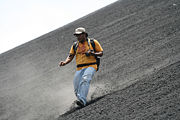
Hiking
Hiking is an outdoor activity which consists of walking in natural environments, often in mountainous or other scenic terrain. People often hike on hiking trails. It is such a popular activity that there are numerous hiking organizations worldwide. The health benefits of different types of hiking...
, climbing
Climbing
Climbing is the activity of using one's hands and feet to ascend a steep object. It is done both for recreation and professionally, as part of activities such as maintenance of a structure, or military operations.Climbing activities include:* Bouldering: Ascending boulders or small...
, camping
Camping
Camping is an outdoor recreational activity. The participants leave urban areas, their home region, or civilization and enjoy nature while spending one or several nights outdoors, usually at a campsite. Camping may involve the use of a tent, caravan, motorhome, cabin, a primitive structure, or no...
, and swimming in crater lakes. Most recently sand skiing has become a popular attraction at the Cerro Negro
Cerro Negro
Cerro Negro is a volcano in the Cordillera de los Maribios mountain range in Nicaragua, about 10 km from the village of Malpaisillo. It is a very new volcano, the youngest in Central America, having first appeared in April 1850...
volcano in León
León, Nicaragua
León is a department in northwestern Nicaragua . It is also the second largest city in Nicaragua, after Managua. It was founded by the Spaniards as Santiago de los Caballeros de León and rivals Granada, Nicaragua, in the number of historic Spanish colonial homes and churches...
. Both dormant and active volcanoes can be climbed. Some of the most visited volcanoes include the Masaya Volcano
Masaya Volcano
Masaya is a shield volcano located 20 km south of Managua, Nicaragua. It is Nicaragua's first and largest National Park, and one of 78 protected areas of Nicaragua. The volcanic complex is composed of a nested set of calderas and craters, the largest of which is Las Sierras shield volcano and...
, Momotombo
Momotombo
Momotombo is a stratovolcano in Nicaragua, not far from the city of León. It stands on the shores of Lago de Managua. An eruption of the volcano in 1610 forced inhabitants of the Spanish city of León to relocate about 30 miles west...
, Mombacho
Mombacho
Mombacho is a stratovolcano in Nicaragua, near the city of Granada. It is 1344 metres high. The Mombacho Volcano Nature Reserve is one of 78 protected areas of Nicaragua. Mombacho is an active volcano but the last eruption occurred in 1570...
, Cosigüina
Cosiguina
Cosigüina is a stratovolcano located in the western part of Nicaragua. It forms a large peninsula extending into the Gulf of Fonseca. The summit is truncated by a large caldera, 2 x 2.4 km in diameter and 500 m deep, holding a substantial crater lake . This cone has grown within an...
and Ometepe
Ometepe
Ometepe is an island formed by two volcanoes rising from Lake Nicaragua in the Republic of Nicaragua. Its name derives from the Nahuatl words ome and tepetl , meaning two mountains...
's Maderas
Maderas
With a height of 1,394 m, Maderas is the smaller of the two volcanoes which make up the island of Ometepe, situated in Lake Nicaragua in Nicaragua, Central America. Unlike Concepción, the other volcano on the island, Maderas has not been active in historical times...
and Concepción
Concepción (volcano)
Concepción is one of two volcanoes that form the island of Ometepe, which is situated in Lake Nicaragua in Nicaragua, Central America....
.
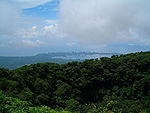
Kayaking
Kayaking is the use of a kayak for moving across water. Kayaking and canoeing are also known as paddling. Kayaking is distinguished from canoeing by the sitting position of the paddler and the number of blades on the paddle...
.
Another popular attraction is the archipelago of 365 islands known as the Islets of Granada
Islets of Granada
The islets of Granada are located in Lake Nicaragua, just southeast of the city of Granada in Nicaragua. The islets are a group of 365 small islands scattered about the Asese peninsula. The islets are of volcanic origin, they were formed when the Mombacho volcano blew most of its cone into the...
(Isletas de Granada). The islets were formed when the Mombacho
Mombacho
Mombacho is a stratovolcano in Nicaragua, near the city of Granada. It is 1344 metres high. The Mombacho Volcano Nature Reserve is one of 78 protected areas of Nicaragua. Mombacho is an active volcano but the last eruption occurred in 1570...
volcano blew most of its cone into the lake, thereby creating the archipelago
Archipelago
An archipelago , sometimes called an island group, is a chain or cluster of islands. The word archipelago is derived from the Greek ἄρχι- – arkhi- and πέλαγος – pélagos through the Italian arcipelago...
. The islets are popular with both locals and tourists. The islets differ in size and have a community of about 1200 people, most of whom make their living as fishermen. Many visitors take boat rides along the islets, which are abundant with many different species of birds and fish.
Popular destinations
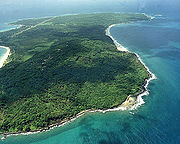
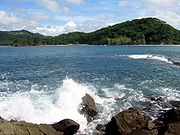
Managua (department)
Managua is a department in Nicaragua. It covers an area of 3,672 km² and has a population of 1,380,300 . The capital is the city of Managua.- Municipalities :# Ciudad Sandino# El Crucero# Managua# Mateare# San Francisco Libre...
:
- ManaguaManaguaManagua is the capital city of Nicaragua as well as the department and municipality by the same name. It is the largest city in Nicaragua in terms of population and geographic size. Located on the southwestern shore of Lake Xolotlán or Lake Managua, the city was declared the national capital in...
, Montelimar BeachMontelimar BeachMontelimar is a beach located on the Pacific coast of Nicaragua in the department of Managua. Montelimar consists of 3 km of white sand beach. The main tourist attraction is the Barcelo Hotel and Resort...
, Mercado Roberto Huembes, Metrocentro, Pharaoh's Casino, Chocoyero-El Brujo Natural ReserveChocoyero-El Brujo Natural ReserveChocoyero-El Brujo Natural Reserve is located in the municipality of Ticuantepe in the Managua department of Nicaragua. Chocoyero-El Brujo is one of 78 protected areas in Nicaragua, and at just this tropical forest is one of the smallest in size...
Department of Granada
Granada (department)
Granada is a department in Nicaragua. It covers an area of 929 km² and has a population of 190,600 . The capital is the city of Granada, one of North America's oldest cities- Municipalities :# Diria# Diriomo# Granada# Nandaime...
:
- GranadaGranada, NicaraguaGranada is a city in western Nicaragua and the capital of the Granada Department. With an estimated population of 110,326 , it is Nicaragua's fourth most populous city. Granada is historically one of Nicaragua's most important cities, economically and politically...
, Parque central, Islets of GranadaIslets of GranadaThe islets of Granada are located in Lake Nicaragua, just southeast of the city of Granada in Nicaragua. The islets are a group of 365 small islands scattered about the Asese peninsula. The islets are of volcanic origin, they were formed when the Mombacho volcano blew most of its cone into the...
Department of León
León (department)
León is a department in Nicaragua. It covers an area of 5,107 km² and has a population of 389,600 . The capital is the city of León.- Municipalities :# El Jicaral# El Sauce# La Paz Centro# Larreynaga# León# Nagarote# Quezalguaque...
- LeónLeón, NicaraguaLeón is a department in northwestern Nicaragua . It is also the second largest city in Nicaragua, after Managua. It was founded by the Spaniards as Santiago de los Caballeros de León and rivals Granada, Nicaragua, in the number of historic Spanish colonial homes and churches...
, Ruins of León, El Fortin, Cerro NegroCerro NegroCerro Negro is a volcano in the Cordillera de los Maribios mountain range in Nicaragua, about 10 km from the village of Malpaisillo. It is a very new volcano, the youngest in Central America, having first appeared in April 1850...
, TelicaTelica (volcano)Telica is a stratovolcano, one of several volcanoes of the Nicaraguan volcanic front, located in the western part of Nicaragua.-Volcanism:...
Department of Rivas
Rivas (department)
Rivas is a department of the Republic of Nicaragua. It covers an area of 2,155 km² and has a population of 166,900 . The department's capital is the city of Rivas.-Overview:...
:
- San Juan del SurSan Juan del SurSan Juan del Sur is a municipality and coastal town on the Pacific Ocean, in the Rivas department in south-west Nicaragua. San Juan del Sur is popular among surfers and is a vacation spot for many Nicaraguan families and foreign tourists....
, OmetepeOmetepeOmetepe is an island formed by two volcanoes rising from Lake Nicaragua in the Republic of Nicaragua. Its name derives from the Nahuatl words ome and tepetl , meaning two mountains...
, Zapatera Island
Department of Masaya
Masaya (department)
Masaya is a department in Nicaragua. It is the country's smallest department by area and has a population of 317,500 . The capital is the city of Masaya.-Municipalities:# Catarina# La Concepción# Masatepe# Masaya# Nandasmo...
:
- Apoyo Lagoon Natural ReserveApoyo Lagoon Natural ReserveLaguna de Apoyo Nature Reserve is a nature reserve located between the departments of Masaya and Granada in Nicaragua...
, MasayaMasayaMasaya, culturally known as the City of Flowers, is the capital city of Masaya department. It is situated approximately 14 km west of Granada and 31 km southeast from Managua. The town of Masaya is situated just East of Masaya Volcano , an active volcano from which the city takes its name...
Department of Río San Juan
Río San Juan (department)
Río San Juan is a department in Nicaragua. It was formed in 1957 from parts of Chontales and Zelaya departments. It covers an area of 7,473 km² and has a population of 95,500 . The capital is San Carlos. The Department also includes the Solentiname Islands archipelago and the San Juan River,...
:
- Solentiname IslandsSolentiname IslandsThe Solentiname Islands are an archipelago towards the southern end of Lake Nicaragua in the Nicaraguan department of Río San Juan...
, El CastilloEl Castillo (village)El Castillo is a village of about 1500 people situated on the southern bank of the Río San Juan in southern Nicaragua. It is one of 27 comarcas of the municipality of El Castillo, a subdivision of the Río San Juan Department. The village is situated approximately 6 kilometers from the border with...
, San CarlosSan Carlos, Río San JuanSan Carlos is the capital city of the municipality of San Carlos and of the Río San Juan Department of Nicaragua. The city proper has a population of roughly 12,174, while the city and surrounding communities contain 37,461 as of 2005. San Carlos is positioned on the confluence of Lake Nicaragua...
, Los Guatuzos Wildlife RefugeLos Guatuzos Wildlife RefugeLos Guatusos Wildlife Refuge has an area of 437.50 square kilometres and is located south of Lake Nicaragua and west of the San Juan River in Nicaragua...
Department of Estelí
Estelí (department)
Estelí is a department of Nicaragua. It covers an area of 2,335 km² and has a population of 215,400 . Its capital is the city of Estelí.- Municipalities :# Condega# Estelí# La Trinidad# Pueblo Nuevo# San Juan de Limay# San Nicolás...
- EstelíEstelíEstelí, officially Villa de San Antonio de Pavia de Estelí is a city and municipality within the Estelí department. It is the third largest city in Nicaragua, an active commercial center in the north and is known as "the Diamond of the Segovias."...
, Mira Flor Nature Reserve
Department of Jinotega
Jinotega (department)
Jinotega is the second largest department in Nicaragua. It is bordered on the north by the country of Honduras. The departments surrounding it are, Matagalpa to the south, Zelaya to the east, and Estelí, Madriz, and Nueva Segovia. It covers an area of 9,755 km² and has a population of 297,300...
- JinotegaJinotegaJinotega is the capital of Jinotega Department in the north central region of Nicaragua.-About:The capital city of the Department of Jinotega is the City of Jinotega. The Department of Jinotega produces 80% of the nation's coffee. It has a population of about 51,000 living inside a vast valley...
, El Jaguar Cloud Forest Reserve
Department of Matagalpa
Matagalpa (department)
Matagalpa is a department or region in central Nicaragua. It covers an area of 8,523 km² and has a population of 644,900 . The capital is the city of Matagalpa with about 250.000....
- Selva Negra Mountain ResortSelva Negra Mountain ResortSelva Negra Mountain Resort and Coffee Estate is a historical coffee farm founded in 1891 by German immigrants. Since 1976 it has also been a tourist resort. It is located in the department of Matagalpa, Nicaragua, just 7 miles from the city of Matagalpa...
, Selva Negra Cloud Forest ReserveSelva Negra Cloud Forest ReserveSelva Negra Cloud Forest Reserve is a nature reserve in Nicaragua. It is one of the 78 reserves which are officially under protection in the country....
Región Autónoma del Atlántico Sur
Región Autónoma del Atlántico Sur
Región Autónoma del Atlántico Sur , sometimes shortened to RAAS, is one of two autonomous regions in Nicaragua. It covers an area of 27,407 km² and has a population of 382,100...
:
- Corn IslandsCorn IslandsThe Corn Islands are two islands about east off the Caribbean coast of Nicaragua, constituting one of 12 municipalities of the Región Autónoma del Atlántico Sur department...
, BluefieldsBluefieldsBluefields is the capital of the municipality of the same name, and of Región Autónoma del Atlántico Sur in Nicaragua. It was also capital of the former Zelaya Department, which was divided into North and South Atlantic Autonomous Regions...
, Laguna de PerlasLaguna de PerlasPearl Lagoon is a town in the municipality by the same name. It is located in Región Autónoma del Atlántico Sur department of Nicaragua...
, Indio Maíz Biological ReserveIndio Maíz Biological ReserveIndio Maíz Biological Reserve measures about 4,500 square kilometers and is situated on the southeastern corner of Nicaragua bordering the San Juan River. It is the second largest expanse of lowland rainforest reserve in Nicaragua and is referred to as "the gem of Central American nature reserves"...
Región Autónoma del Atlántico Norte
Región Autónoma del Atlántico Norte
Región Autónoma del Atlántico Norte , sometimes shortened to RAAN, is one of two autonomous regions in Nicaragua. It covers an area of 32,159 km² and has a population of 249,700 . It is the largest autonomous region or department in Nicaragua...
:
- Puerto CabezasPuerto CabezasPuerto Cabezas is a municipality in, and capital of, the North Atlantic Coast department of Nicaragua....
, Bosawas Biosphere ReserveBosawás Biosphere ReserveThe Bosawás Biosphere Reserve in the northern part of Nicaragua is a hilly tropical forest designated in 1997 as a UNESCO biosphere reserve. At approximately 20,000 km² in size, the reserve The Bosawás Biosphere Reserve in the northern part of Nicaragua is a hilly tropical forest designated...
See also
- Protected areas of Nicaragua
- Wildlife of NicaraguaWildlife of NicaraguaThe fauna of Nicaragua is characterized by a very high level of biodiversity. Much of Nicaragua's wildlife lives in protected areas. There are currently 78 protected areas in Nicaragua, covering more than , or about 17% of its landmass. These protected areas encompass a wide variety of habitats,...
- Economy of NicaraguaEconomy of NicaraguaNicaragua's economy is focused primarily on the agricultural sector. However, the country is the least developed country in Central America and the second poorest in the Americas by nominal GDP. GDP fell by almost 3% in 2009, due to decreased export demand in the US and Central American markets,...
- Museums of Nicaragua
- Wikitravel:Nicaragua
External links
- New York Times Travel Guides: Nicaragua
- San Juan del Sur Surfing
- ViaNica.com
- ElUniversal.com.mx Nicaragua destaca en ecoturismo
- Alternativas al Turismo de Sol y Playa
- Ideas for tourists

